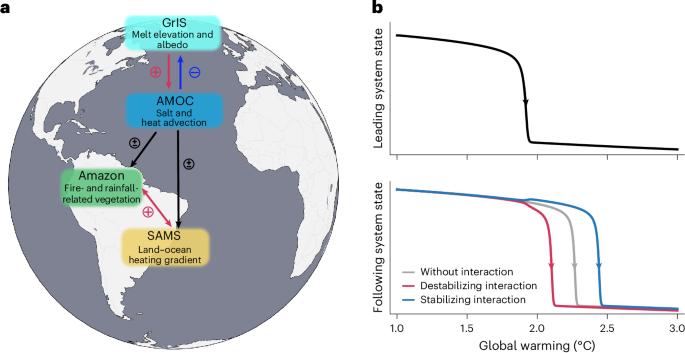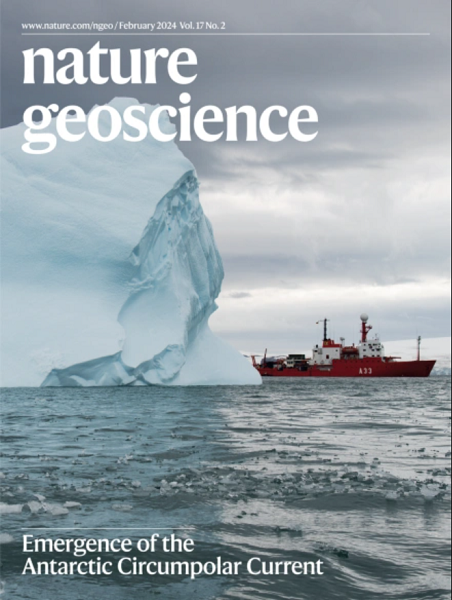地球系统引爆要素的不稳定性
IF 16.1
1区 地球科学
Q1 GEOSCIENCES, MULTIDISCIPLINARY
引用次数: 0
摘要
人们越来越担心,地球系统的一些部分可能会突然过渡到另一种稳定状态,以响应人为气候和土地利用变化。这些引爆因素的主要候选因素包括格陵兰冰盖、大西洋经向翻转环流、南美季风系统和亚马逊雨林。由于它们之间通过海洋和大气耦合产生的复杂动力学和反馈,可以预期向替代状态过渡的人为强迫水平仍然不确定。在这里,我们展示了这种相互作用如何产生虚假信号,并可能掩盖不稳定的真正迹象。我们进一步回顾并提出了基于观测的证据,表明这四个临界点因素的稳定性在近几十年来有所下降,表明它们已经接近临界阈值,在未减缓的人为变暖范围内可能会超过临界阈值。我们的研究结果呼吁更好地监测这些引爆因素,并加大努力阻止温室气体排放和土地利用变化。对基于观测的证据的审查表明,四个相互关联的地球系统引爆因素已接近其临界阈值,这突出表明需要更好地监测和加强缓解努力。本文章由计算机程序翻译,如有差异,请以英文原文为准。

Destabilization of Earth system tipping elements
There is rising concern that several parts of the Earth system may abruptly transition to alternative stable states in response to anthropogenic climate and land-use change. Key candidates of such tipping elements include the Greenland Ice Sheet, the Atlantic Meridional Overturning Circulation, the South American monsoon system and the Amazon rainforest. Owing to the complex dynamics and feedbacks between them via oceanic and atmospheric coupling, the levels of anthropogenic forcing at which transitions to alternative states can be expected remain uncertain. Here we demonstrate how such interactions can generate spurious signals and potentially mask genuine signs of destabilization. We further review and present observation-based evidence that the stability of these four tipping elements has declined in recent decades, suggesting that they have moved towards their critical thresholds, which may be crossed within the range of unmitigated anthropogenic warming. Our results call for better monitoring of these tipping elements and for increased efforts to stop greenhouse gas emissions and land-use change. A review of observation-based evidence suggests that four interconnected Earth system tipping elements have moved towards their critical thresholds, highlighting the need for better monitoring and increased mitigation efforts.
求助全文
通过发布文献求助,成功后即可免费获取论文全文。
去求助
来源期刊

Nature Geoscience
地学-地球科学综合
CiteScore
26.70
自引率
1.60%
发文量
187
审稿时长
3.3 months
期刊介绍:
Nature Geoscience is a monthly interdisciplinary journal that gathers top-tier research spanning Earth Sciences and related fields.
The journal covers all geoscience disciplines, including fieldwork, modeling, and theoretical studies.
Topics include atmospheric science, biogeochemistry, climate science, geobiology, geochemistry, geoinformatics, remote sensing, geology, geomagnetism, paleomagnetism, geomorphology, geophysics, glaciology, hydrology, limnology, mineralogy, oceanography, paleontology, paleoclimatology, paleoceanography, petrology, planetary science, seismology, space physics, tectonics, and volcanology.
Nature Geoscience upholds its commitment to publishing significant, high-quality Earth Sciences research through fair, rapid, and rigorous peer review, overseen by a team of full-time professional editors.
 求助内容:
求助内容: 应助结果提醒方式:
应助结果提醒方式:


